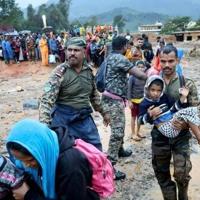Search for survivors of landslides in Indian tea plantations was hindered on Wednesday by relentless downpours and howling winds, leading to the death of at least 150 people, mostly laborers and their families.
The southern coastal state of Kerala has been experiencing days of heavy monsoon rains, blocking roads into the disaster area in the Wayanad district and complicating relief efforts.
With the main bridge connecting the severely affected villages of Chooralmala and Mundakkai destroyed, rescue teams had to transport bodies on stretchers out of the disaster zone using a makeshift zipline over flooded waters.
Some survivors who managed to escape the initial landslides found themselves trapped in a nearby river that had overflowed, as volunteer rescuer Arun Dev described at a hospital treating survivors.
“Those who survived were swept away along with houses, temples, and schools,” he said.
Senior police officer M.R. Ajith Kumar reported that around 500 people were rescued after successive landslides occurred before dawn on Tuesday.
“So far, over 150 bodies have been recovered,” he stated.
“There are still large areas to be searched to find out if there are any survivors.”
Wayanad is known for its tea estates that cover its hilly terrain, relying on a large workforce for planting and harvesting.
The disaster struck a number of brick-walled row houses built for seasonal workers, inundating them in mud as they slept inside.
More than 3,000 people are seeking shelter in emergency relief camps around the district, according to the state government.
The region received 572 millimeters of rain in the two days leading up to the landslides, causing severe damage.
Kerala’s disaster agency warned of more rain and strong winds on Thursday, posing a risk of further damage to unsafe structures across the state.
– ‘Adverse weather conditions’ –
Indian opposition leader Rahul Gandhi, who used to represent Wayanad in parliament, shared that his planned visit to the disaster area had to be canceled due to heavy rains and adverse weather conditions.
“Our thoughts are with the people of Wayanad during this challenging time,” he added.
Monsoon rains from June to September provide relief from the summer heat and are crucial for agriculture and water supply replenishment.
While these rains are essential for farming and food security, they also bring destruction, with the number of fatal floods and landslides increasing in recent years due to climate change.
“India will see more impacts of heavy rainfall disasters triggered by climate change in the future,” said Kartiki Negi of the Indian environment think tank Climate Trends.
India’s worst landslide in recent history occurred in 1998, killing at least 220 people in the Himalayan village of Malpa due to rockfalls caused by heavy monsoon rains.
ash/gle/smw





